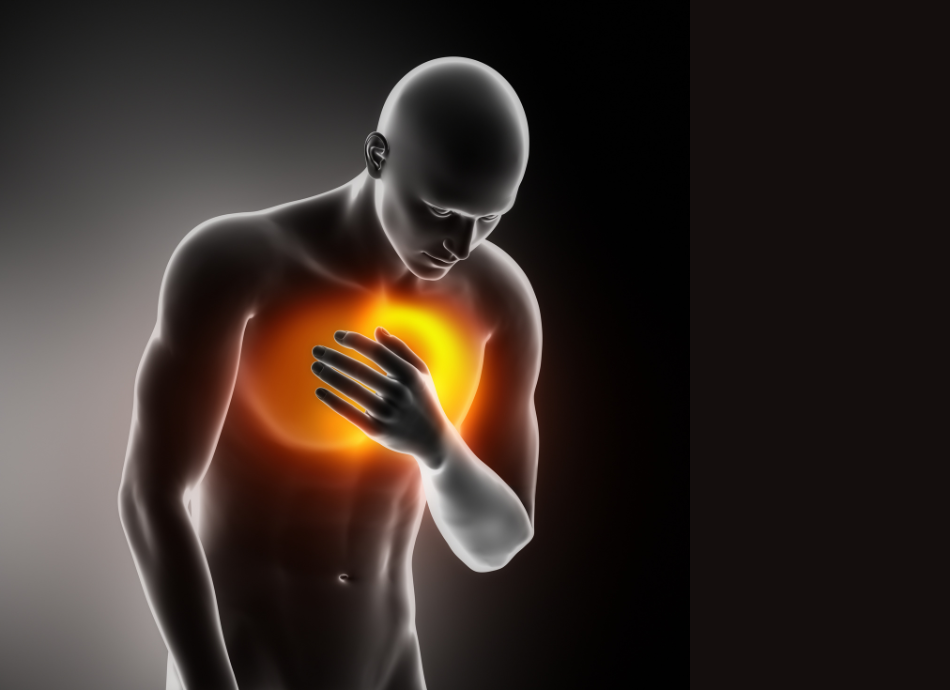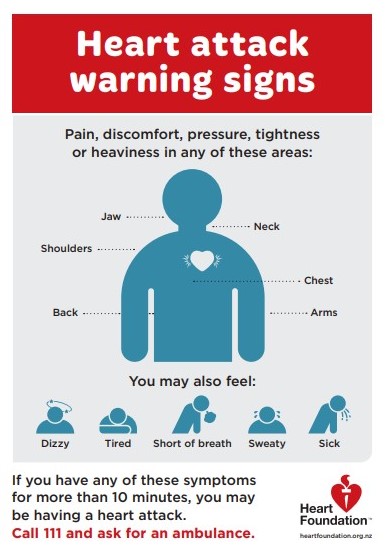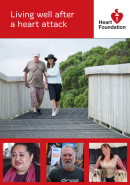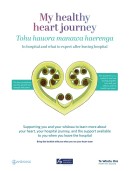Heart attack | Hē manawa
Also known as a myocardial infarction (MI)
Key points about heart attack (hē manawa)
- Heart attack occurs when blood flow to a section of heart muscle becomes blocked.
- If the flow of blood isn’t returned quickly, the section of heart muscle becomes damaged from lack of oxygen and starts to die.
- Heart attack symptoms vary. Some are sudden and intense but most start slowly, with mild pain or discomfort that can be easily mistaken for indigestion (heartburn).
- If you have severe chest pain for more than a few minutes, assume it's a heart attack.
- A heart attack is a medical emergency and you need immediate medical help.

Symptoms of heart attack vary. However, if you have severe chest pain for more than 10 minutes, assume it's a heart attack.
Heart attack action plan
Minutes matter with a heart attack and early treatment can be life-saving. Make sure you have a heart attack action plan.
Know the warning signs
- Heavy pressure, tightness, crushing pain or unusual discomfort in the centre of your chest. This may stop or get less intense and then return. This symptom may not be the most noticeable symptom, especially in women.
- Pain spreading to your shoulders, neck, jaw and/or arms, and in some cases, through to your back.
- You may also sweat, have a sick feeling in your stomach, feel dizzy and be short of breath. These symptoms are the ones women most commonly notice.
If you have any of these symptoms for more than 10 minutes you may be having a heart attack. Don't delay, call 111 for an ambulance.
Take action immediately
- Call 111, ask for the ambulance service and tell them you're having a possible heart attack.
- If available, chew 1 aspirin, unless you have been previously advised not to take aspirin.
- Rest quietly and wait for the ambulance.
- Get someone to wait with you, if possible.
- Remaining calm means you are less likely to suffer some of the heartbeat disturbances that create problems for you and your immediate medical advisors.
Get it checked out
People often don't know what's wrong and wait too long before getting help. The warning signs of a heart attack vary and it's possible to have no pain (especially if you are a woman or have diabetes) or the only sign may be indigestion-type pain (heartburn).
Even if you're not sure it's a heart attack, have it checked out.
- Fast action can save lives
- Calling 111 is almost always the fastest way to get life-saving treatment. Emergency medical services staff can begin treatment when they arrive.
- Don't travel by car if there is a possibility of a heart attack occurring.
Video: What causes a heart attack?
(Heart Foundation, NZ, 2023)
Coronary arteries are blood vessels that supply the heart muscle with blood and oxygen. In a heart attack there is a sudden blockage of a coronary artery by a blood clot.
If the flow of blood isn’t returned quickly, that section of heart muscle becomes damaged from lack of oxygen and starts to die. This results in poor beating action of that area, so the blood from your heart can’t get to vital organs like your brain. Your heartbeat may become irregular, further reducing the blood needed elsewhere.
If blood flow isn't returned to the heart muscle within 20–40 minutes, irreversible death of the heart muscle will begin. Muscle continues to die for 6–8 hours, at which time the heart attack is usually ‘complete’. The dead heart muscle is eventually replaced by scar tissue.
What leads to this happening?
A heart attack can happen out of the blue, but it is more commonly the result of 3 processes:
- the development over many years of fatty deposits (plaques) on the walls of your arteries
- a clot forming on one of the plaques, resulting in a blockage of that artery
- the blockage stopping blood flow to a section of heart muscle and, sometimes, the electrical impulses your heart responds to also stop working properly.
Fatty plaques can start building up on the inside walls of your coronary arteries (atherosclerosis) at an early age. Over the years, the build up of these plaques increases and they become larger. As a result, your arteries gradually become narrower and less elastic. At this stage you may experience chest pain (also known as angina).
As your arteries narrow, there's less room for blood to flow through. If a clot forms on the plaque, the artery can become blocked, cutting off the blood supply to part of the heart muscle. This is when a heart attack occurs.
Some heart attacks are sudden and intense but most heart attacks start slowly, with mild pain or discomfort that can be easily mistaken for indigestion (heartburn). Symptoms are often different for men than they are for women. Often an attack is triggered by some form of exercise or heavy work but this isn't always the case.
Chest pain/discomfort
If you have chest pain that lasts more than a few minutes it may be a sign of a heart attack.
The pain may:
- feel like squeezing, pressing, tightness or fullness
- come and go (at first)
- be in one or both arms (more commonly the left)
- go into your neck, back, jaw, stomach and abdomen
Symptoms in women
Chest discomfort may not be the worst, or most noticeable, symptom for women. Women are more likely than men to experience the following symptoms, with or without chest discomfort:
- sweating
- feeling faint
- feeling sick
- vomiting (being sick)
- being short of breath
- palpitations (a noticeably fast, strong or irregular heartbeat).
You may not experience all of these symptoms. If you are experiencing some of them call 111 without delay. See also why women ignore heart attack symptoms.
Video: Heart attack warning signs
This video may take a few moments to load.
(Heart Foundation, NZ, 2021)
A heart attack needs urgent medical attention. If you think you are having a heart attack:
- Call 111 and ask for an ambulance and let them know you may be having a heart attack.
- If available, chew one aspirin, unless you have been previously advised not to take aspirin.
- Rest quietly and wait for the ambulance.
- Get someone to wait with you, if possible.
- Remaining calm means you are less likely to suffer some of the heartbeat disturbances that create problems for you and your immediate medical advisors.
Minutes matter with a heart attack and early treatment can be life-saving. Make sure you have a heart attack action plan so you know what to do if you have a heart attack – read about heart attack action plans below.
What happens in the ambulance?
Ambulances attending people with chest pain generally have a paramedic crew member trained in coronary (heart) resuscitation. They also have all the appropriate equipment and medicines, including a defibrillator, which can deliver a measured electric shock to your heart if a dangerous heart rhythm occurs.
They will also have an ECG (electrocardiogram) monitor. They will set up an intravenous line (a soft tube placed inside a vein) so the paramedic can give you medicine quickly and effectively. You may be given aspirin and pain relief by the ambulance officer.
What happens in hospital?
Once you're at the hospital, you'll be treated in the emergency department (ED). The doctors will perform tests to find out whether or not you've had a heart attack. These tests include an ECG and blood tests for cardiac enzymes (these are released into your body by damaged heart muscle cells). Read more about heart disease tests.
You'll be given medicine to help you recover. This may include a thrombolytic (clot busting) drug, which helps to break down the clot. You may need a procedure called an angioplasty to widen a coronary artery.
Once your condition is stable, you'll be transferred to a specialist ward called the Coronary Care Unit (CCU). As your heart becomes more stable, the ECG monitoring will be taken away. You'll be able to walk gently around the ward, with help.
You may be given medicine, including aspirin, which helps to reduce your risk of more clots developing. Further blood tests will be needed before you can go home. If there are no more problems you can look forward to going home in a few days.
What happens when I am discharged from hospital?
Cardiac rehabilitation is an important part of recovery. It can significantly increase your chances of recovering successfully and help to prevent another heart attack.
For more information about the recovery process, see the Heart Foundation's booklet Living well after a heart attack.(external link)
During a heart attack, part of your heart is starved of oxygen. Heart muscle is especially sensitive to a drop in oxygen carried in your bloodstream. This drop can interrupt your heart's rhythm and can cause it to suddenly beat ineffectively or stop beating altogether. This is known as cardiac arrest. Cardiac arrest is life-threatening and requires immediate medical attention. Read more about cardiac arrest.
A number of things or factors increase your chances of developing coronary heart disease. The more risk factors you have, the greater your chance of having a heart attack. You can’t change some of your risk factors (eg, your age, sex, ethnicity and family history) but there are many others you can change. These include:
- smoking
- blood pressure
- weight
- activity level
- how much alcohol you drink.
Making positive changes to reduce the impact of these risk factors will dramatically reduce your risk of cardiovascular disease and heart attack.
Read more about heart disease risk factors.
Apps reviewed by Healthify
You may find it useful to look at some Quit smoking apps, Blood pressure apps, Alcohol use apps, Nutrition, exercise and weight management apps and Self-management apps.
Heart Foundation NZ(external link) provides information and support for people who are living with a heart condition. Visit their website(external link) or call the Heart Line on 0800 863 375. This phone line is managed by a consumer care representative who can support you with heart health information, health service navigation and access to resources and support.
Heart attack(external link) Heart Foundation, NZ
Heart attack(external link) NHS, UK
Heart attack – explained(external link) American Heart Association, US
Apps
First aid and emergency apps
Quit smoking apps
Blood pressure apps
Alcohol use apps
Nutrition, exercise and weight management apps
Self-management apps
Brochures
My healthy heart journey – Tohu hauora manawa haerenga [PDF, 5 MB] Te Whatu Ora and Ministry of Health, NZ
Heart attack – warning signs poster(external link) Heart Foundation, NZ
Living well after a heart attack(external link) Heart Foundation of NZ
Why should I have a regular heart check?(external link) HealthEd, NZ, 2013
You and your ICD(external link) Heart Foundation, NZ
References
- Heart attack(external link) Health New Zealand | Te Whatu Ora, 2023
- Heart attack – causes and warning signs(external link) Heart Research Institute, NZ
- What is a heart attack?(external link) Heart Foundation, NZ
Clinical resources
The immediate management of acute coronary syndromes in primary care(external link) BPAC, NZ, 2015
National Heart Foundation of Australia & Cardiac Society of Australia and NZ – Australian clinical guidelines for the management of acute coronary syndromes 2016(external link) Heart, Lung and Circulation 2016;25:895–951.
Chest pain of recent onset – assessment and diagnosis(external link) National Institute for Health and Care Excellence, UK, 2016
ST-elevation myocardial infarction – NZ management guidelines(external link) NZ Medical Journal, 2013 Dec 13; 126(1387)
A follow-up to acute coronary syndromes(external link) BPAC, NZ, 2015
Acute myocardial infarction in women(external link) Circulation. 2016;133:916–947.
2015 ACC/AHA/SCAI focused update on primary percutaneous coronary intervention for patients with ST-elevation myocardial infarction: an update of the 2011 ACCF/AHA/SCAI guideline for percutaneous coro(external link) Circulation 2016;133:1135–1147.
2014 AHA/ACC guideline for the management of patients with non–ST-elevation acute coronary syndromes(external link) Journal of the American College of Cardiology (JACC), December 2014
See our page Heart failure for healthcare providers
Continuing professional development
Chest pain and acute coronary syndrome - Prof. Gerry Devlin (44 minutes)(external link) (PHARMAC Seminars, NZ, 2019)
Heart attack and stroke – getting the blood flowing again(external link) (University of Auckland, NZ, 2018)
Apps
First aid and emergency apps
Quit smoking apps
Blood pressure apps
Alcohol use apps
Nutrition, exercise and weight management apps
Self-management apps
Brochures

Heart Foundation, NZ

Heart Foundation of NZ, 2020

Credits: Healthify editorial team. Healthify is brought to you by Health Navigator Charitable Trust.
Reviewed by: Dr Art Nahill, Consultant General Physician and Clinical Educator
Last reviewed:





